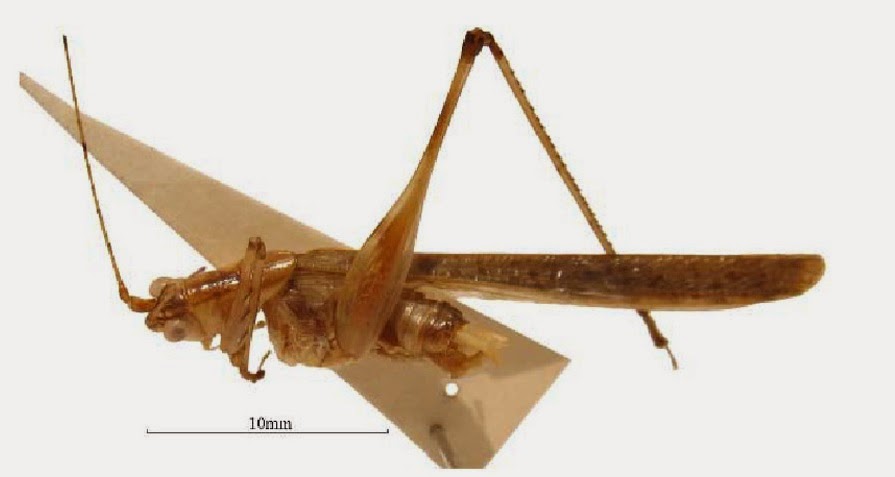Katydids of the genus Xizicus
and its close relatives are found across eastern Asia, though the taxonomy of
the group is currently somewhat confused, in part due to publications being
published in different languages without translation. New species are being
described within the group every year, with different authors using slightly
different classifications. Several subgenera have been created within the
genus, some of which have been promoted to full genus status, others being synonymized
(a taxa described separately by two different authors is correctly called by
the first name used, the second description becoming a junior synonym of the
first; junior synonyms are not used subsequently, but are recorded so that
taxonomists encountering them know what they refer to).
In a paper published in the journal Zootaxa on 16 September 2014,
Hanqiang Wang and Jun Jing of the School of Life Science at East China NormalUniversity in Shanghai, Xianwei Liu of the Shanghai Entomological Museum of the
Chinese Academy of Sciences and Kai Li, also of the School of Life Science at
East China Normal University, revise the genus Xizicus, raising the number of subgenera within the genus from two
(Xizicus and Paraxizicus) to four (Xizicus,
Paraxizicus, Zangxizicus and Haploxizicus),
and three new species are described.
The first new species described is placed in the subgenus Xizicus (Paraxizicus) and given the specific name fallax, meaning ‘similar’ due to its similarity to Xizicus (Paraxizicus) biprocerus. Xizicus (Paraxizicus) fallax is a
yellowish Katydid with dark lines along its body, with females slightly larger
than males. It is found in Guangxi and Jiangxi Provinces, China.
Xizicus (Paraxizicus) fallax (top)
male and (bottom) female.Wang et al.
(2014).
The second new species is placed in the new
subgenus Xizicus (Zangxizicus), which derives from a
combination of the genus name (Xizicus)
and ‘Xizang’, the Chinese name for Tibet, and given the specific name quadrifascipes, meaning ‘four-stripes’,
referring to markings on the hind femora. This species is described from a
single male specimen from Motuo County in Xizang, at an altitude of 1060 m, which is
yellow and brown in colour.
Xizicus (Zangxizicus) quadrifascipes, male specimen.Wang et al. (2014).
The third new species is also placed in the
subgenus Xizicus (Zangxizicus), and given the specific
name tibeticus, which derives from
Tibet. This species is described from a single male from Chayu in Xizang, found
at an altitude of 1900 m, and a single female from Motuo, at an altitude of
1100 m. Xizicus (Zangxizicus) tibeticus is
a yellowish brown Katydid, the male slightly smaller than the female.
Xizicus (Zangxizicus) tibeticus(top) male and (bottom) female.Wang
et al. (2014).
The second new subgenus
erected is named Xizicus (Haploxizicus), in reference to the male
anatomy (expand). This subgenus is erected to include five previously described
species from China, previously placed in different taxa.
See also…
Katydids (or Bush Crickets) are members of the Cricket and Grasshopper
Order, Orthoptera, noted for their exceptionally long antennae and the
way in which they...
Bush Crickets, or Katydids, are large Insects in the Order Tettigoniidae, related to Grasshoppers and True Crickets. The are distributed widely around the globe, but reach their maximum diversity in the tropics and in temperate North America. The males of each species attract their mates with a distinctive call, made by...
Bush Crickets, or Katydids, are large Insects in the Order Tettigoniidae, related to Grasshoppers and True Crickets. The are distributed widely around the globe, but reach their maximum diversity in the tropics and in temperate North America. The males of each species attract their mates with a distinctive call, made by...
Reconstructing the sounds made by ancient organisms is not something
that palaeontologists can normally attempt. There are some fairly well
published studies on Hadrosaurs, which suggest that if they had chosen
to...
Follow Sciency Thoughts on Facebook.
Follow Sciency Thoughts on Facebook.







